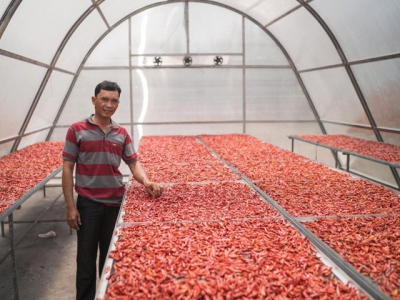Solar dryer dome technology solution enhance climate change resilience

Solar Dryer Parabola Dome is the result of 30 years of research by Dr. Serm Janjai of Silpakorn University. The dryer works with the principles of greenhouse drying for agricultural products such as bananas, tomatoes, chili, coffee, cocoa, spices and herbs, etc.
Drying chili in Dong Thap, Vietnam
Their parabolic shape allows the best use of solar radiation, and rain water runs off easily. The polycarbonate sheets used to cover the dome creating the greenhouse effects are made of high-value, high-quality Covestro polycarbonate, and are coated with a UV protection layer. Being shielded from UV, agricultural produce keeps its vibrant colors and valuable nutrient values. This results in higher valued final products.
The dryer is easy to transport, and is installed locally. It reduces significantly the risk of spoilage and hygiene concerns caused by dust, water contamination, and livestock animals.

Small size Solar Dryer Dome (6m x 8m)

Large size Solar Dryer Dome (9m x 22m)
This solution in post-harvesting processing can help tackle the post-harvest loss and enhance the resilience against climate change among farming communities in Southeast Asia.
For example, according to the Climate Change Scenarios for Vietnam 2016 – Report by Vietnam Ministry of Natural Resources and Environment, the rainfall indicator differs strongly between the climate change scenario in 2012 and in 2015. Rainfall, as forecast in 2012, would actually decrease by 2-12% but is now predicted to increase by 5-15% (from the period of 2016-2035). High rainfall increases in rainy season while in dry season, rainfall tends to decrease. Hence, drought and floods would become more complicated. Consequently, conventional drying in open air will face more challenges. Unpredictable weather encourages moving post-harvesting activities to closed space.
A sustainable inclusive business model to scale this drying solution has been established in Myanmar and Indonesia; however, still under development in Vietnam. More details on these inclusive business models will be shared in upcoming entries.
Inclusive Business Development Manager, Covestro Vietnam
Có thể bạn quan tâm
 Embodied Resource Use In Feed-Based Aquaculture
Embodied Resource Use In Feed-Based Aquaculture In life cycle analysis of aquaculture, there is a danger of the entire array of embodied resources and impacts being assigned to the production facility
 Drying, Liming, Other Treatments Disinfect Pond Bottoms
Drying, Liming, Other Treatments Disinfect Pond Bottoms Drying pond bottoms between cycles is the first step toward disinfection. Puddles and wet areas should receive lime or another effective treatment to eliminate
 Dissolved-Oxygen Requirements In Aquatic Animal Respiration
Dissolved-Oxygen Requirements In Aquatic Animal Respiration In aquatic animals, blood hemo-globin unloads oxygen to the tissue fluids. Coldwater species have higher dissolved-oxygen concentration requirements
 Lake, Reservoir Characteristics Affect Cage Culture Potential
Lake, Reservoir Characteristics Affect Cage Culture Potential Factors that include area, volume and flushing rates interact to affect water quality in lakes and reservoirs.
 Feed Efficiency Indicators for Responsible Aquaculture
Feed Efficiency Indicators for Responsible Aquaculture Environmentally responsible, profitable aquaculture has its foundation in efficient resource use. Feed usually is the most costly item in aquaculture production